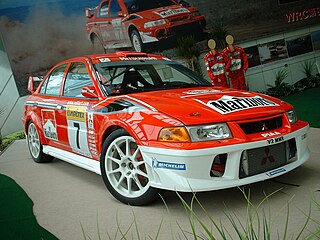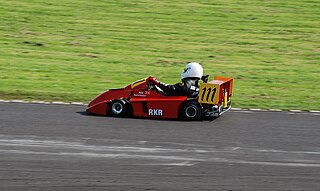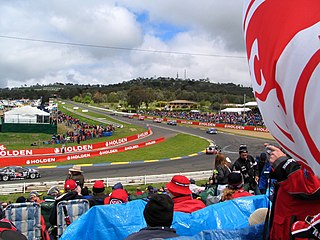Related Research Articles

Formula Two, abbreviated to F2, also called Formula 2, is a type of open-wheel formula racing first codified in 1948. It was replaced in 1985 by Formula 3000, but revived by the FIA from 2009–2012 in the form of the FIA Formula Two Championship. The name returned in 2017 when the former GP2 Series became known as the FIA Formula 2 Championship.

Group A is a set of motorsport regulations administered by the FIA covering production derived vehicles intended for competition, usually in touring car racing and rallying. In contrast to the short-lived Group B and Group C, Group A vehicles were limited in terms of power, weight, allowed technology and overall cost. Group A was aimed at ensuring numerous entries in races of privately owned vehicles.

Superkart is a form of motorsport road racing that uses karts on long circuits.

Australian Formula 2, sometimes abbreviated to AF2 or ANF2, is a "wings and slicks" formula racing category in Australia. The category is one of Australia's oldest, dating back to 1964. The current format of AF2 was introduced in 1978. Brian Shead of Cheetah Racing Cars and Garrie Cooper of Elfin Racing Cars were largely responsible for the development of the format, which was devised to suit the needs of Australian drivers, most of whom had little or no sponsorship and had to bear the costs of racing out of their own pockets.

Motorsport is a popular spectator sport in Australia, although there are relatively few competitors compared to other sports due to the high costs of competing. The oldest motorsport competition in Australia is the Alpine Rally which was first staged in 1921 followed by the Australian Grand Prix, first staged in 1928. The most widely watched motorsport category is Supercars, especially at the Bathurst 1000. Other classes in Australia include Australian GT, Formula 3 and Formula Ford, Superbikes, as well as various forms of speedway racing.
The Australian Drivers' Championship was a motor racing championship contested annually from 1957 to 2014 by drivers of cars complying with Australia's premier open-wheeler racing category as determined by the Confederation of Australian Motor Sport. From 2005 to 2014 this category was Formula 3 and the championship was promoted as the Formula 3 Australian Drivers' Championship. Each year, the winner was awarded the CAMS Gold Star. The title was revived in 2021 for the new S5000 category.
The 1975 Australian Drivers' Championship was a CAMS sanctioned Australian motor racing title open to Australian Formula 1 cars and Australian Formula 2 cars. The championship winner was awarded the 1975 CAMS "Gold Star". The title, which was the nineteenth Australian Drivers' Championship, was won by John McCormack driving an Elfin MR6 Repco-Holden.
Australian Formula 3 has been the name applied to two distinctly different motor racing categories, separated by over twenty years.
Formula Pacific was a motor racing category which was used in the Pacific Basin area from 1977 to 1982. It specified a single-seat, open-wheeler chassis powered by a production-based four-cylinder engine of under 1600cc capacity. The formula was based on Formula Atlantic, with provision made for the use of Japanese engines. The category was superseded in 1983 by Formula Mondial, which was devised by the FIA to replace both Formula Atlantic and Formula Pacific.
The 1982 Australian Grand Prix was a motor race held at the Melbourne International Raceway, formerly Calder Raceway, in Victoria, Australia on 8 November 1982.
The 1986 Australian Drivers' Championship was a CAMS sanctioned Australian motor racing title for Formula Mondial racing cars. It was the 30th Australian Drivers' Championship. The championship winner was awarded the 1986 CAMS Gold Star.

The Australian GT Championship is a CAMS-sanctioned national title for drivers of GT cars, held annually from 1960 to 1963, from 1982 to 1985 and from 2005. Each championship up to and including the 1963 title was contested over a single race and those after that year over a series of races. The categories which have contested the championship have not always been well defined and often have become a home for cars orphaned by category collapse or a sudden change in regulation.

The Toyota Racing Series is New Zealand's premier "open-wheeler" motorsport category. The Series includes races for every major trophy in New Zealand circuit racing including the New Zealand Motor Cup and the Denny Hulme Memorial Trophy. The cars are also the category for the New Zealand Grand Prix – one of only two races in the world with FIA approval to use the Grand Prix nomenclature outside Formula One.

Australian Formula 1 (AF1) was a motor sport category for open-wheeler racing cars which was current in Australia from 1970 to 1983.

The Australian National Formula was an Australian motor racing category which was introduced by the Confederation of Australian Motor Sport in 1964 and remained current until the end of 1969. It had replaced Formula Libre as the Australian premier racing formula.
The 1983 Australian Drivers' Championship was a CAMS sanctioned motor racing title open to drivers of Australian Formula 1 racing cars. The winner of the title, which was the 27th Australian Drivers' Championship, was awarded the 1983 CAMS Gold Star.
The 1986 Australian Endurance Championship was a CAMS sanctioned motor racing title open to Touring Cars as specified in the National Competition Rules of CAMS. The title, which was the sixth Australian Endurance Championship, was contested concurrently with the 1986 Australian Manufacturers' Championship, which was the sixteenth in a sequence of manufacturers championships awarded by CAMS, and the seventh to be contested under the Australian Manufacturers' Championship name.
A 1979 Australian Drivers' Championship was a CAMS sanctioned national motor racing title for drivers of Australian Formula 1 racing cars. The championship winner was awarded the 1979 CAMS Gold Star. The title, which was the 23rd Australian Drivers' Championship, was won by Johnnie Walker, driving a Lola T332.
The 1985 Australian Drivers' Championship was a CAMS sanctioned Australian motor racing title open to racing cars complying with Formula Mondial. It was the 29th Australian Drivers' Championship and the fourth to be contested by Formula Pacific-based Australian Formula 1 cars or by the similar Formula Mondial cars. The championship winner was awarded the 1985 CAMS Gold Star.
The 1978 Australian Drivers' Championship was a CAMS sanctioned Australian motor racing title open to Racing Cars complying with Australian Formula 1. It was the 22nd Australian Drivers' Championship to be awarded by CAMS. The title winner, Graham McRae, was awarded the 1978 CAMS Gold Star.
References
- 1 2 3 4 The Macquarie Dictionary of Motoring, 1986, page 171
- 1 2 Australian Motor Racing Yearbook, 1982/83, page 11
- ↑ CAMS Manual of Motor Sport 1985, page 262
- ↑ CAMS Manual of Motor Sport 1986, page 264
- 1 2 3 Australian Motor Racing Yearbook, 1983/84, page 233
- ↑ 1983 FIA Formula Mondial North American Cup Retrieved from www.champcarstats.com on 19 February 2010
- ↑ CAMS Manual of Motor Sport 1983, page 273
- ↑ The Official 50-race history of the Australian Grand Prix, 1986, page 466
- ↑ The Official 50-race history of the Australian Grand Prix, 1986, page 478
- ↑ Australian Motor Racing Yearbook, 1984/85, page 203